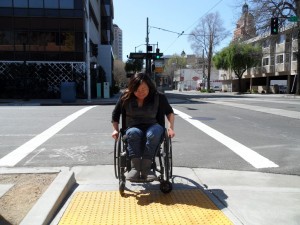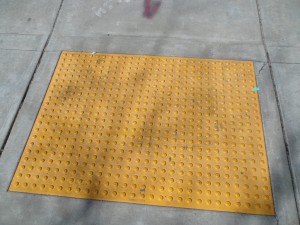By Shannon Coe, Reuse and Finance Coordinator
As you are crossing the street, many of you may notice the yellow dots on the curb ramps. You may even notice them covering the entire crosswalk from the front of the shopping mall to the parking lot. The yellow dots, also known as truncated domes, are an Americans with Disabilities Act (ADA) requirement. After the ADA was enacted in 1990, cities had to put in curb ramps between the street and sidewalk. But the curb ramps were a problem for people with visual impairments because they lost the visual cue to distinguish the boundary between the sidewalk and street. In order to resolve this issue, the Americans with Disabilities Act Accessibility Guidelines (ADAAG), required detectable warnings on curb cuts since July 2001. It has been required on edges of transit platforms since 1991. And only the truncated domes can be used as detectable warnings. Other tactile warnings and designs that have similar pavement textures as curb ramps are not permitted.
The intent of the truncated domes is to warn people with visual impairments of potential hazard when entering the street. People with visual impairments can feel the dots underneath their feet or cane to detect the crosswalk.
Although I understand the purpose of truncated domes, I find them to be unsafe for people with mobility impairments. Many of my friends who use manual wheelchairs, including myself, secretly complain how truncated domes create barriers for us. Why do we complain secretly? Because if we complained openly, people may think we are insensitive and do not care for the rights of people with visual impairments. But this is not true; we want to maintain unity in the disability community. Nevertheless, every time I approach the yellow dots on the curb ramp in my manual wheelchair, I tremble with fear that I might trip on one of the yellow dots and fall on my face. I know of friends in manual wheelchairs who have tripped on the dots and ended up in hospitals with broken bones. Whenever I cross the street, I need the momentum to push myself up and down the curb ramp but the dots are too bumpy. My front wheels are small so they cannot ride over the bumps easily. Furthermore, the bumps trigger muscle spasms for some people with spinal cord injury.
 |
| Shannon carefully navigating a curb cut with truncated domes |
Therefore, should one disability trump another disability? Even though we should accommodate the needs of all people with disabilities, we should also “share the road.” Instead of putting truncated domes all around curb ramps or storefronts, I suggest leaving sections without truncated domes so people in wheelchairs can easily access those areas. This small change can make a huge difference in the safety of people with mobility impairments.
Share your thoughts about truncated domes. Do you think we need them? Are there other options for universal access?






What a great idea to have flat strips in the middle of the truncated domes for people in wheelchairs or even moms with strollers or those needing to push through with other carts.
I do agree with Shannon truncated domes can be a hazard to people with Spinal Cord Injuries in manual wheelchairs. If someone in a manual wheelchair has speed the truncated domes can stop them in their tracks and throw the person out of their manual chair. I have seen able bodied women in high heels fall and hurt themselves walking in the rain on the truncated domes. Also, waking up the babies in the baby stroller to damaging your eggs you just bought at Costco. I realize the truncated domes were designed for the good of one disability but a hazard to another. Something, better needs to be designed that would serve both visual impaired and wheelchair users for all disabilities to be safe.
When I am pushing a cart of groceries over the truncated domes it is difficult to get over them. I can’t imagine how hard it must be for someone in a wheelchair. There has to be a better design for everyone with a disability. Hopefully not one more person will fall from their chair and break both legs before a better design is found.
I completely agree with Shannon. I even linked to it in my own blog, where I mention things I like and things I dislike as a disabled person: http://viewfromthehandicappedspace.blogspot.com/2012/08/yippee-some-places-that-make-my.html?showComment=1344260819334#c9080952216125556932
Oops. Actually my link should end at html.
Like this: http://viewfromthehandicappedspace.blogspot.com/2012/08/yippee-some-places-that-make-my.html
I am a spinal cord disabled person in a wheelchair. I sometimes use a scooter, too. This is scary over the domes, as it slips and tips, especially when wet. I am fearful of a fall. I resent the use of these domes in areas other than the curbs, too. As if we didn’t have enough trouble with them outside, my hospital has put them inside their parking garage, too! So, whenever I go to rehab I must cross 4 sets of these each day!
These new ramps are frightening. I wish there were a better way. I have cerebral palsy, and I must use those ramps to get up the curb. These ramps make walking dangerous, and when it rains they also get very slippery.
My 2 1/2 was walking out of walgreens yesterday. They have truncated domes that are brick. Well, he tripped and busted his face, head and toe pretty bad. I picked him up as he was oozing blood and went into the store. No one helped until a customer came to our rescue. How safe are these truncated domes. I understand the argument for visually impaired but what about the rest of the world? Children included? Any help or advice is appreciated. Thank you!
My mom in her 80s tripped on these truncated cones at a market and hit her head. These are truly dangerous and there should be a class-action lawsuit to replace them with a safer design.
These are sensors that can read the chip in your ID s, and computers and gps from smart phones andcan monitor your travel, beware of why anyone wants to have that much capable information to everyone, even bus systems make you buy a pass showing ss numbers with birthcertificate, believe me they know every stop time and date of every trip..
these truncated domes are horrible for elder people in a walker!!! it’s hard to believe that’s the best they can do to improve accessibility. It seems to me there are more mobility impaired people than visually impaired. this is truly ridiculous!!! PC that’s not PC
I have had to use a knee walker for many weeks over the past few years and I have an awful time on these bumps. Most of them that I see are red not yellow but all the same, they create a problem for me in the knee walker.